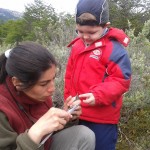 For the past 3 years, researchers at the Austral Center for Scientific Research have led an initiative to establish long-term avian research in Tierra del Fuego Island. With the support of Birder’s Exchange, these scientists are working with the staff of Tierra del Fuego National Park and local tourism operators to link the ecological research with other social actors and bring greater awareness and involvement of the citizens of Ushuaia to the forest birds that surround the world’s southernmost city. To date, this project has helped to establish seasonal patterns of forest avifauna and also determined specific vegetation and habitat conditions required for particular species. The goal of this program is not only to involved different social actors in the research being conducted in the national park, but also bring tools that decision makers can use in the future to improve the design of protected areas, specifically bringing a landscape level focus to the study of biota and habitat in southern Patagonia.
For the past 3 years, researchers at the Austral Center for Scientific Research have led an initiative to establish long-term avian research in Tierra del Fuego Island. With the support of Birder’s Exchange, these scientists are working with the staff of Tierra del Fuego National Park and local tourism operators to link the ecological research with other social actors and bring greater awareness and involvement of the citizens of Ushuaia to the forest birds that surround the world’s southernmost city. To date, this project has helped to establish seasonal patterns of forest avifauna and also determined specific vegetation and habitat conditions required for particular species. The goal of this program is not only to involved different social actors in the research being conducted in the national park, but also bring tools that decision makers can use in the future to improve the design of protected areas, specifically bringing a landscape level focus to the study of biota and habitat in southern Patagonia.
Category Archives: Cape Horn Research
NatGeo Awards Grant to Study Riparian Forest Restoration in Tierra del Fuego
 The National Geographic Society recently awarded a Young Explorer Grant to Jon Henn, who together with Drs. Guillermo Martínez Pastur, Vanessa Lencinas and Christopher Anderson, prepared the project to study the methods needed to restore riparian Nothofagus forests in Tierra del Fuego after the removal of invasive beavers. Mr. Henn will work with researchers in Tierra del Fuego for a year with the support of a Fulbright Scholarship, as well. During that time, this team seeks to determine key information regarding the ecophysiology and regenerative capacity of Nothofagus trees in beaver meadows. In this context, the research will also be linked with other ongoing studies funded by the U.S. National Science Foundation to better understand and manage invasive species and ecosystem services in southern Patagonia (see below).
The National Geographic Society recently awarded a Young Explorer Grant to Jon Henn, who together with Drs. Guillermo Martínez Pastur, Vanessa Lencinas and Christopher Anderson, prepared the project to study the methods needed to restore riparian Nothofagus forests in Tierra del Fuego after the removal of invasive beavers. Mr. Henn will work with researchers in Tierra del Fuego for a year with the support of a Fulbright Scholarship, as well. During that time, this team seeks to determine key information regarding the ecophysiology and regenerative capacity of Nothofagus trees in beaver meadows. In this context, the research will also be linked with other ongoing studies funded by the U.S. National Science Foundation to better understand and manage invasive species and ecosystem services in southern Patagonia (see below).
Linking the Public, Private and Academic Sectors for Sustainable Forest Management in Tierra del Fuego
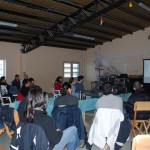 Dr. Guillermo Martínez Pastur, a respected forester and leader of the Forest Resource Research Group in the Austral Center for Scientific Research (CADIC-CONICET, Ushuaia, Argentina) was recently invited by the government of Sweden to be part of an elite team including 15 world-renowned forestry researchers to help rationalize the sustainable use of Scandinavian forests. Upon his return to Tierra del Fuego, Dr. Martínez Pastur convened a local workshop, held in the town of Tolhuín, to report the findings of this global effort to understand forestry in high latitudes, including experiences from Europe, North America and Tasmania.
Dr. Guillermo Martínez Pastur, a respected forester and leader of the Forest Resource Research Group in the Austral Center for Scientific Research (CADIC-CONICET, Ushuaia, Argentina) was recently invited by the government of Sweden to be part of an elite team including 15 world-renowned forestry researchers to help rationalize the sustainable use of Scandinavian forests. Upon his return to Tierra del Fuego, Dr. Martínez Pastur convened a local workshop, held in the town of Tolhuín, to report the findings of this global effort to understand forestry in high latitudes, including experiences from Europe, North America and Tasmania.
As Dr. Martinez Pastur reported, the measures implemented in the Argentine portion of Tierra del Fuego Island are exemplary on a global scale, with up to 70% of a harvested forest being left for conservation. However, he also noted that many of these best practices are based on a local culture that has involved scientists in the development of their business models and should now be codified into rules and laws to prevent future companies lacking this ethic to become established and viciate the virtuous cycle that has been established.
According to Dr. Christopher Anderson, also invited to attend the workshop, “what really jumps to my mind about this effort is that Guillermo’s team is able to convene a group of people willing to spend a day discussing these issues of sustainable forest management that come from the public sector, including the Provincial Forest and Parks Services, the private sector, including representatives from the two leading forestry companies in Tierra del Fuego that make of 60% of forest extraction, and academics from both the CADIC and Chile.”
UMAG Student Wins CONCIYT Scholarship
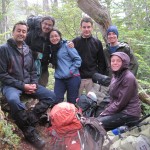 Ernesto Davis, M.S. candidate at the Universidad de Magallanes (left in photo), recently became one of the first UMAG students to obtain a scholarship from the Chilean National Science Commission (CONICYT). According to the evaluation, Mr. Davis was also the highest ranked applicant in the whole country. Previously, this student was also supported by OSARA and his thesis seeks to develop a habitat occupation model for invasive North American beavers in the Fuegian Archipelago.
Ernesto Davis, M.S. candidate at the Universidad de Magallanes (left in photo), recently became one of the first UMAG students to obtain a scholarship from the Chilean National Science Commission (CONICYT). According to the evaluation, Mr. Davis was also the highest ranked applicant in the whole country. Previously, this student was also supported by OSARA and his thesis seeks to develop a habitat occupation model for invasive North American beavers in the Fuegian Archipelago.
UNT Fulbrighter in Chile
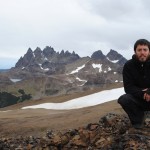 The first month of my Fulbright-Chile experience has already by far exceeded all my expectations. Once arriving to Punta Arenas I joined a group of students that I would be spending the next few weeks with for an international, interdisciplinary field course on conservation in the Cape Horn Biosphere Reserve. On arrival to Puerto Williams, the southern most town in the world, we began a number of activities with the park’s researchers. Our purpose was to gain a hands-on education in and contribute towards conservation through a series of multidisciplinary activities including group discussions, short lectures, artistic expression, community interaction, and field research among many other
The first month of my Fulbright-Chile experience has already by far exceeded all my expectations. Once arriving to Punta Arenas I joined a group of students that I would be spending the next few weeks with for an international, interdisciplinary field course on conservation in the Cape Horn Biosphere Reserve. On arrival to Puerto Williams, the southern most town in the world, we began a number of activities with the park’s researchers. Our purpose was to gain a hands-on education in and contribute towards conservation through a series of multidisciplinary activities including group discussions, short lectures, artistic expression, community interaction, and field research among many other
field activities.
I was given the responsibility of teacher’s assistant (TA) for the course. As a recently recruited graduate student at the University of North Texas my advisors and Fulbright host thought it a great way to introduce me to the region while allowing me to support the program as Fulbright student.
The course, entitled Tracing Darwin’s Path, is a newly developed form of conservation which is conscious of and emphasizes the idea that biodiversity is inextricably linked to and supported by cultural diversity. The course introduced approaches and methods for developing solutions to local and global conservation issues; cultural and environmental. Specific highlights which came up often in the interviews were: a three day ferry ride through the beagle channel to Puerto Williams; three nights camping at Róbolo Lake; a basket weaving lesson with a member of the Yaghan indigenous community; the ability to assist in the research occurring on Navarino Island; and the international experience gained from interacting with students from all over the world and from many different disciplines.
When finished with the course most of us who were flying back to Punta Arenas from Puerto Williams were held up due to the protests occurring in Punta Arenas at the time over gas rate hikes implemented by the national government. Though for some it became a bit of an inconvenience, for me and most of the others, it gave the group some cultural insight on regional political issues. We felt compassion for the people fighting to keep affordable a resource needed for survival in the cold rainy climate of the Magallanic region.
Once I made it back to Punta Arenas I embarked on the first of a series of annual navigations to explore the spectacular isolated sounds of Tierra del Fuego with some of the world’s leading bryologists, and a team of Chilean students from the UMAG. The main intention of the navigations is to survey the region for its mosses and liverworts. All in all, the navigation was an unforgettable experience where I traversed terrains seen by few. Those images of the strikingly
sculpted mountains and brilliantly blue creeping glaciers will stay with me forever.
For the next two months I will be living and traveling between Punta Arenas and Puerto Williams for participatory research as a means to adjust my broader research methods to the contours of the local culture. My goals for the upcoming month are to refine my project methodology so as to be ready to begin field work in; make contacts with regional scientists and natural resource managers; summarize the results of my interviews, and continue developing a paper that I and a few others were inspired to start during the course.
Jean-Paul Zagarola, taken from the January-March Fulbright Newsletter 2011
New York Botanical Garden Teams Up with Universidad de Magallanes in Expedition to Describe the Mosses of Cape Horn
 Since 2002, researchers from the New York Botanical Garden (NYBG) and the Universidad de Magallanes to better understand and conserve the amazing diversity of mosses, lichens and liverworts found in the Cape Horn archipelago. Early results of this collaboration showed that Cape Horn hosts 7% of the world’s diversity of non-vascular plants on only 0.01% of the planet’s surface area. Using this information, the Omora Park’s team of students, philosophers and scientists turned this ecological fact into socially relevant results, including part of the justification of the creation of the Cape Horn Biosphere Reserve (CHBR) in 2005.
Since 2002, researchers from the New York Botanical Garden (NYBG) and the Universidad de Magallanes to better understand and conserve the amazing diversity of mosses, lichens and liverworts found in the Cape Horn archipelago. Early results of this collaboration showed that Cape Horn hosts 7% of the world’s diversity of non-vascular plants on only 0.01% of the planet’s surface area. Using this information, the Omora Park’s team of students, philosophers and scientists turned this ecological fact into socially relevant results, including part of the justification of the creation of the Cape Horn Biosphere Reserve (CHBR) in 2005.
In 2010, this inter-institutional and international team of researchers, including not only NYBG and the University of North Texas, but also individuals from the Field Museum, Duke University and the California Academy of Sciences, obtained new funding from the U.S. National Science Foundation to conduct a series of month-long, boat-based expeditions in Cape Horn between 2011 and 2014. These trips to remote areas that are difficult to access and infrequently visited will allow scientists to collect and identify specimens with the goal of creating a complete inventory of the moss and liverwort species found in the archipelago and publish a definitive work on the Bryoflora of Cape Horn.
Through the SABCP, this basic science project is also linked with local research, education and conservation initiatives based at the Omora Park, which is one of three networked long-term socio-ecological research sites in Chile. For example, the Omora Park has been developing a novel special interest tourism project with the support of the Chilean Ministry of Economy’s Corporation for Business Development (CORFO), which is enabling the improvement of training, publications and infrastructure for the implementation of “Tourism with a Hand Lens”, a unique opportunity for local tourism operators to obtain economic benefit by leading visitors on a discovery of the singular diversity of bryophytes and lichens found in the Omora Park and Cape Horn archipelago.
Plus, in addition to the funding from the NSF, partial support of the current expedition (January-February 2011) has also been provided by the Weeden Foundation, based in New York, to aid the participation of Chilean students from the Universidad de Magallanes’ Masters of Science in Sub-Antarctic Conservation Program. In this way, students working on projects in marine science, invasive species, moss/insect interactions and watershed ecosystem services were also able to participate with the prestigious team of bryologists, thereby facilitating broader impacts of this expedition in the areas of interdisciplinary research and training of students from the U.S. and Chile.
Students from Puerto Williams Again at the Top of Regional Science Fair
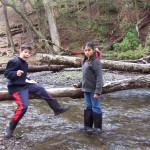 Yet again, students from the Puerto Williams School who participate in the Omora Workshop on Natural History have taken first place in the regional science fair, sponsored by Explora-CONICYT. This year, the Omora-Puerto Williams team was represented by two groups from primary and high school. The first team, including Carlos Saavedra and Francisco Olivares, won FIRST PRIZE in the elementary student category. These students were led by Tamara Contador, a Ph.D. student in Biology from the University of North Texas and the Institute of Ecology and Biodiversity, and teacher Maria Anguita. They presented their work on Richness and abundance of freshwater invertebrates in submerged rocky and wood habitat of the Ukika River, Navarino Island, Cape Horn Biosphere Reserve (55º S).
Yet again, students from the Puerto Williams School who participate in the Omora Workshop on Natural History have taken first place in the regional science fair, sponsored by Explora-CONICYT. This year, the Omora-Puerto Williams team was represented by two groups from primary and high school. The first team, including Carlos Saavedra and Francisco Olivares, won FIRST PRIZE in the elementary student category. These students were led by Tamara Contador, a Ph.D. student in Biology from the University of North Texas and the Institute of Ecology and Biodiversity, and teacher Maria Anguita. They presented their work on Richness and abundance of freshwater invertebrates in submerged rocky and wood habitat of the Ukika River, Navarino Island, Cape Horn Biosphere Reserve (55º S).
UNT-UMAG Launch New Edition of Multi-Ethnic Bird Guide
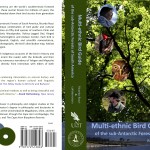 In 1995, Ricardo Rozzi and a group of colleagues working on Chiloe Island first had the idea of creating a bird guide that would take into account diverse forms of knowing these abundant and diverse creatures. Over the past 15 years, numerous photographers, artists, researchers, poets, students and native elders have worked to produce the the Multi-Ethnic Bird Guide to the Sub-Antarctic Forests of South America. In this unique book, Rozzi and collaborators combine science and traditional ecological knowledge about fifty bird species of southern Chile, providing its names in Yahgan, Mapudungun, Spanish, English and scientific nomenclature, an ecological description, full color photographs and distribution maps. According to Dr. Chris Elphick (co-author of the Sibley Guide to Bird Life and Behavior) this publication is “highly original in its approach of combining information on natural history and biodiversity with information on the region’s human culture and linguistic diversity.”
In 1995, Ricardo Rozzi and a group of colleagues working on Chiloe Island first had the idea of creating a bird guide that would take into account diverse forms of knowing these abundant and diverse creatures. Over the past 15 years, numerous photographers, artists, researchers, poets, students and native elders have worked to produce the the Multi-Ethnic Bird Guide to the Sub-Antarctic Forests of South America. In this unique book, Rozzi and collaborators combine science and traditional ecological knowledge about fifty bird species of southern Chile, providing its names in Yahgan, Mapudungun, Spanish, English and scientific nomenclature, an ecological description, full color photographs and distribution maps. According to Dr. Chris Elphick (co-author of the Sibley Guide to Bird Life and Behavior) this publication is “highly original in its approach of combining information on natural history and biodiversity with information on the region’s human culture and linguistic diversity.”
Dr. Christopher Anderson, coordinator of the Sub-Antarctic Biocultural Conservation Program, noted that “this is the first in a series of publications that Dr. Rozzi has preposed and that our program has undertaken to establish and editorial line in biocultural conservation between the University of North Texas and the Universidad de Magallanes. The goal is to create field guides, translations and original scholarship that facilitates communication and dialogue between the humanities and the sciences and between Latin America and English-speaking America.”
To launch this book, the Sub-Antarctic Biocultural Conservation Program hosted an evening celebration of art, poetry, philosophy and science, which was headlined by co-author, poet and uñumche (Mapuche birdman) Lorenzo Aillapán to UNT to offer his poetry in a public presentation and to various classes. Likewise, Paola Vezzani, designer of the new edition and currently Regional Director of Culture for Magallanes, attended the launching ceremony to talk about the link this book expresses between science and the arts. These events also coincided with the one year anniversary of the Sub-Antarctic Biocultural Conservation Program, which allowed as well the inauguration of the program’s new offices in the EESAT Building, an event attended by the university administration, faculty, student and other friends.
For more information or to order this new book visit UNT Press.
Sub-Antarctic Biocultural Conservation Session at UNT Scholars Day
 In the annual undergraduate Scholars Day at UNT, this year the Sub-Antarctic Biocultural Conservation Program was represented with an organized session of 3 posters that included:
In the annual undergraduate Scholars Day at UNT, this year the Sub-Antarctic Biocultural Conservation Program was represented with an organized session of 3 posters that included:
–> Stephen Dillenberg presenting his analysis of the historical trends in conservation research regarding the inclusion of ecological and social criteria. His findings showed a clear bias within academia to consider principally ecological considerations, while broader social criteria are still lacking.
–> Kelli Moses and a host of collaborators for their part presented the Miniature Forests of Cape Horn and how this novel research-conversation program has been able to link local, regional, national and international scales.
–> Michael Simanonok, for his part, gave the results of his honors thesis, which was supported by an NSF IRES grant. His work explored the dual effects of forestry and invasive beavers on stream ecosystems in Tierra del Fuego, finding that well managed forestry practices were able to maintain natural biodiversity and stream function, while beaver meadows exhibited high impacts on streams (see previous story on Mike’s award).
U.S. State Department Visits Cape Horn to Implement Binational Cooperation
 In January 2010, the U.S. and Chilean governments agreed on their binational environmental cooperation agenda. For the first time, this plan includes the implementation of the Cape Horn Biosphere Reserve as a priority for both governments. In the meetings held in Washington, Drs. Ricardo Rozzi, Mary Kalin and Kenneth Sewell represented our program’s activities in the governmental meetings, in addition to sustaining talks with the Ecological Society of America and the National Science Foundation. In April, Dr. Jacqueline Tront from the State Department’s Office of Environmental Policy visited the Magallanes Region to hold meetings with the regional government authorities, including the regional director of CORFO (see photo) and the governor of the Chilean Antarctic Province. In addition, she held conversations with University of Magallanes officials and regional tourism operators to understand the meaning and impact of the Sub-Antarctic Biocultural Conservation Program’s effort to link research and sustainability. The State Department is interested not only in supporting this novel venture in Cape Horn, but also taking the lessons learned at this remote wilderness area for application in other parts of Latin America and the world where their office works to mitigate the environmental impacts of trade.
In January 2010, the U.S. and Chilean governments agreed on their binational environmental cooperation agenda. For the first time, this plan includes the implementation of the Cape Horn Biosphere Reserve as a priority for both governments. In the meetings held in Washington, Drs. Ricardo Rozzi, Mary Kalin and Kenneth Sewell represented our program’s activities in the governmental meetings, in addition to sustaining talks with the Ecological Society of America and the National Science Foundation. In April, Dr. Jacqueline Tront from the State Department’s Office of Environmental Policy visited the Magallanes Region to hold meetings with the regional government authorities, including the regional director of CORFO (see photo) and the governor of the Chilean Antarctic Province. In addition, she held conversations with University of Magallanes officials and regional tourism operators to understand the meaning and impact of the Sub-Antarctic Biocultural Conservation Program’s effort to link research and sustainability. The State Department is interested not only in supporting this novel venture in Cape Horn, but also taking the lessons learned at this remote wilderness area for application in other parts of Latin America and the world where their office works to mitigate the environmental impacts of trade.
Subantarctic Biocultural Conservation Program Publishes New Book on the Invertebrates of Cape Horn
 Jaime Ojeda, UMAG M.S. Conservation student and Tamara Contador, UNT Ph.D. Biology student, have both worked at the Omora Park for several years. In 2008, they proposed to their advisers that they apply for funding from the Chilean National Environment Commission to support their research regarding marine and freshwater invertebrates, a grant which they won. The resulting project has allowed them not only to conduct their theses, but also to work in the local school with children and other residents to explore the “hidden” biodiversity of small organisms found underwater. Now, this project has produced a field guide entitled Guide the the Aquatic Invertebrates of the Cape Horn Biosphere Reserve. With the aid of Drs. Ricardo Rozzi, Christopher Anderson, James Kennedy, Andrés Mansilla and Francisca Massardo, the students indicate how to identify and describe the role of these small creatures in our subantarctic ecosystems. The book is expected to help educators, tourism operators and the general public get to know these often unknown and unappreciated members of our biotic community. With the support of the University of North Texas and the Universidad de Magallanes, the Omora Park and the Subantarctic Biocutltural Conservation Program is also formalizing an editorial line between UMAG and UNT that will continue to produce these natural history guides for the subantarctic ecoregion, as well as other texts related to environmental ethics and biocultural conservation. Stay tune for news on the launching of the Multi-ethnic Bird Guide to the Subantarctic Forests of Southern South America in May!
Jaime Ojeda, UMAG M.S. Conservation student and Tamara Contador, UNT Ph.D. Biology student, have both worked at the Omora Park for several years. In 2008, they proposed to their advisers that they apply for funding from the Chilean National Environment Commission to support their research regarding marine and freshwater invertebrates, a grant which they won. The resulting project has allowed them not only to conduct their theses, but also to work in the local school with children and other residents to explore the “hidden” biodiversity of small organisms found underwater. Now, this project has produced a field guide entitled Guide the the Aquatic Invertebrates of the Cape Horn Biosphere Reserve. With the aid of Drs. Ricardo Rozzi, Christopher Anderson, James Kennedy, Andrés Mansilla and Francisca Massardo, the students indicate how to identify and describe the role of these small creatures in our subantarctic ecosystems. The book is expected to help educators, tourism operators and the general public get to know these often unknown and unappreciated members of our biotic community. With the support of the University of North Texas and the Universidad de Magallanes, the Omora Park and the Subantarctic Biocutltural Conservation Program is also formalizing an editorial line between UMAG and UNT that will continue to produce these natural history guides for the subantarctic ecoregion, as well as other texts related to environmental ethics and biocultural conservation. Stay tune for news on the launching of the Multi-ethnic Bird Guide to the Subantarctic Forests of Southern South America in May!
Yet Another Fulbrighter in Cape Horn!
With only 2,000 human inhabitants, Cape Horn is quite likely the place on earth with the highest number of Fulbrighters per capita! To the existing cohort of 4, including Juan Harcha, Christopher Anderson, Ricardo Rozzi and James Kennedy, we are now proud to announce that Jean-Paul Zagarola has been selected for a Fulbright Fellowship in 2011 to conduct research in the Cape Horn Biosphere Reserve associated with community-based watershed management and the perception and valuation of ecosystem services of watersheds. Mr. Zagarola will be admitted to the Environmental Science Program at the University of North Texas in the fall of 2010, where he will pursue a masters degree under the mentorship of Drs. Anderson and Kennedy. “This is truly an exceptional achievement for JP. In addition, as the first new recruit since our program was formalized at UNT and the Universidad de Magallanes, we are very pleased. If all goes well he will become the first joint masters of subantarctic biocultural conservation student we produce with the UMAG as well”, said Christopher Anderson regarding this news. For more on previous Fulbright winners from Cape Horn click here.
Report from “6th Southern Connection Conference”
.jpg) During the 6th Southern Connection Conference, carried out in Bariloche, Argentina from 15-19 February 2010, the Sub-Antarctic Biocultural Conservation Program co-sponsored with its Chilean and Argentine colleagues a symposium to address the use of long-term socio-ecological research (LTSER) sites as a platform to affect conservation and management of the southern temperate forest biome found in Argentina, Chile, New Zealand and Australia. The Southern Connection Conference is a tri-annual meeting of ecologists, geographers, geologists and paleobiologists, begun in 1993 as an effort for the countries that were once part of the Gondwana supercontinent (Argentina, Chile, South Africa, Australia and New Zealand), to have the opportunity to share experiences and to generate collaborations. The invited participants to the LTSER symposium included representatives from Chile, Argentina and Tasmania, in the Program’s broader effort to promote LTSER initiatives in the Southern Hemisphere. In this context, the event co-organized by Dr. Christopher Anderson, Subantarctic Program Coordinator, and Dr. Guillermo Martinez Pastur, a forest ecologist at the Austral Scientific Research Center in Ushuaia, Argentina, was intended to further the ongoing work of the University of North Texas, the University of Magallanes and the Institute of Ecology and Biodiversity to implement a Chilean network of LTSER sites that work also on the integration of academic disciplines and the academy with society. Additionally, the Program will launch in March a special edition of the Revista Chilena de Historia Natural, which shares the proceedings of a previous workshop held at the Omora Park in 2008 about this topic.
During the 6th Southern Connection Conference, carried out in Bariloche, Argentina from 15-19 February 2010, the Sub-Antarctic Biocultural Conservation Program co-sponsored with its Chilean and Argentine colleagues a symposium to address the use of long-term socio-ecological research (LTSER) sites as a platform to affect conservation and management of the southern temperate forest biome found in Argentina, Chile, New Zealand and Australia. The Southern Connection Conference is a tri-annual meeting of ecologists, geographers, geologists and paleobiologists, begun in 1993 as an effort for the countries that were once part of the Gondwana supercontinent (Argentina, Chile, South Africa, Australia and New Zealand), to have the opportunity to share experiences and to generate collaborations. The invited participants to the LTSER symposium included representatives from Chile, Argentina and Tasmania, in the Program’s broader effort to promote LTSER initiatives in the Southern Hemisphere. In this context, the event co-organized by Dr. Christopher Anderson, Subantarctic Program Coordinator, and Dr. Guillermo Martinez Pastur, a forest ecologist at the Austral Scientific Research Center in Ushuaia, Argentina, was intended to further the ongoing work of the University of North Texas, the University of Magallanes and the Institute of Ecology and Biodiversity to implement a Chilean network of LTSER sites that work also on the integration of academic disciplines and the academy with society. Additionally, the Program will launch in March a special edition of the Revista Chilena de Historia Natural, which shares the proceedings of a previous workshop held at the Omora Park in 2008 about this topic.
Fulbright Creates Regional Award to Benefit Research in Cape Horn
 Recently, the Chilean Fulbright Commission announced the creation of “regional” awards that will be available to select centers of excellence deemed capable of participating in this prestigious scholarship program. Fortunately, the Masters of Science in Subantarctic Conservation Program, coordinated by the University of Magallanes in assocation with the Institute of Ecology and Biodiversity and the University of North Texas, was one of only 4 centers in Chile which will compete for the 2-3 Science Initiative scholarships to be provided annually. According to Dr. Christopher Anderson, Magallanes Regional Delegate for the Chilean Fulbright Commission, “the inclusion in this group is not only a high recongition of the quality of the work being conducted in the Cape Horn Biosphere Reserve by the UMAG’s graduate students, but also offers a new opportunity to strengthen the international interaction of the students and scientists working in the Omora Park.”
Recently, the Chilean Fulbright Commission announced the creation of “regional” awards that will be available to select centers of excellence deemed capable of participating in this prestigious scholarship program. Fortunately, the Masters of Science in Subantarctic Conservation Program, coordinated by the University of Magallanes in assocation with the Institute of Ecology and Biodiversity and the University of North Texas, was one of only 4 centers in Chile which will compete for the 2-3 Science Initiative scholarships to be provided annually. According to Dr. Christopher Anderson, Magallanes Regional Delegate for the Chilean Fulbright Commission, “the inclusion in this group is not only a high recongition of the quality of the work being conducted in the Cape Horn Biosphere Reserve by the UMAG’s graduate students, but also offers a new opportunity to strengthen the international interaction of the students and scientists working in the Omora Park.”
